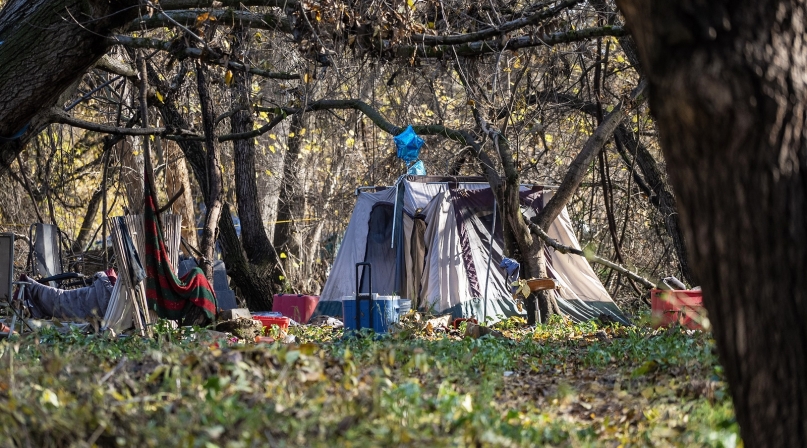County parks departments double as outreach to homeless campers

Key Takeaways
Out of sight but not out of mind for Adams County, Colo. parks and open space staff, encampments were ticking time bombs.
Behind screens of trees and vegetation, the communities of illegal campers were becoming a hazard. And every now and then, some would take a weapon and stop hikers in the park, demanding money to let them pass.
Others were vulnerable themselves to the elements and too far away from anyone who could render aid.
“It was dangerous for trail users, and they were all living within the flood plain, so if we had a flash flood, we could have seen potentially hundreds of people drown,” Byron Fanning, the department’s director, said of the situation that got out of hand three years ago, in 2019.
Learn more
The National Recreation and Park Association: Addressing Homelessness in Public Parks
“When we did finally clear it, we found 150 propane tanks, so we were a mishap away from disaster, a forest fire or an explosion.”
But as counties work to clear encampments in their parks and open spaces, they are trying to offer dignity and respect in the process, treating the interaction as a way to introduce people living outdoors to human services offerings. This takes on added importance as temperatures drop into the winter, posing both a threat to the health of people living outdoors and a rising risk of campfires spreading.
“It’s not an easy issue and we’re not solving it, but we are addressing it in a way that is respectful and supportive of the community of folks experiencing homelessness,” Fanning said.
The 2018 Martin v. Boise decision by the Ninth Circuit bars governments from punishing unhoused people for sleeping outside on public property in the absence of adequate alternatives, setting a national precedent. But while local public lands often serve as the last refuge of the helpless, the privacy they afford also keeps outside observers from being able to spot behavioral problems compounding. Creeks and streams that offer an alternative to plumbing can turn campsites into biological hazards when overloaded with waste.
And because the encampments are often so far off the beaten path, law enforcement is often not close enough to help when needed.
Sacramento County, Calif. counted six homicides in 2021 among residents of encampments along the American River Parkway, along with 170 fires in entire parks system throughout the year, most of which were likely manmade. In 2022, a woman visiting the parkway was raped and murdered in the park, and her alleged murderer lived in an encampment. Those conditions prompted the Board of Supervisors to pass an ordinance in August banning encampments along the American River Parkway, which has seen an extensive community of tents develop alo the paved multi-use trail.
“We had been providing notices to vacate to campers all along,” said Liz Bellas, director of Sacramento County’s Department of Regional Parks. “Once an area is cleared, if the same risks still apply, then we work to keep the area clear.”
By establishing that the parkway is off limits for camping, the county can comply with Martin v. Boise.
Counties have developed procedures to formalize a process that gives campers ample time to move before their belongings are removed, while also getting results and limiting damage to park land.
Parks and Open Space Director Kyla Brown said Riverside County, Calif. staffers typically get voluntary compliance when they prompt campers to move.
“In those cases, we try to educate folks and help them understand why the area they’re in is not appropriate for them to stay in, what sensitive habitat might exist, what other risks might exist for them, but it would be from weather or animals or wildfire potential,” she said.
If the campers spurn those overtures, they are given a two-week notice that their encampment will be cleaned, along with a 48-hour notice. The parks staff has the sheriff’s office on hand for cleanings, with protocols to save any items that might be used for shelter or food.
“We try to make it less inviting to come back there — reducing cover and fire fuels,” Brown said.
Riverside County Parks and Open Space meets every other month with local cities, water and flood control districts and the Army Corps of Engineers to collaborate on funding opportunities for behavioral health resources and housing.
“We don’t get our fair share of formula funding for resources like these, so we have to be creative and look for opportunities,” she said.
Sacramento County coordinates visits from both law enforcement and navigators, who help introduce campers to the Department of Human Assistance (DHA) offerings.
“We tend to have them do their outreach prior to us going in and providing the notice to vacate,” Bellas said.
“It’s coordinated but it’s separate because you want to maintain the trust of folks and for some people, bringing both groups together, the DHA side and the law enforcement side, doesn’t help that situation.”
In Adams County, Fanning said interactions between parks and open space staff and campers were strained before the county started its trail ranger program.
“We were asking our parks employees, who are typically mowing and picking up trash and spraying weeds, to confront these people experiencing homelessness and move them on with the Sheriff’s Office backing them up,” he said. “We started experiencing turnover because they just didn’t want to do it and then the supervisors and even the director before me were doing it because they didn’t want to ask their people to handle those situations.”
The rangers led the way on enforcement, explaining the rules of the parks and developing relationships with the campers, accompanied by staffers from the county’s department of Community Safety and Well-being, who offer support from the county’s human services agencies.
“Now we’re able to be proactive as soon as we see encampments, the ranger service immediately makes contact and addresses the situation and they’re able to move it on quickly,” Fanning said.
While LaFortune Park in Tulsa County, Okla. forbids overnight camping, it is welcoming to all users, and offers amenities of kindred spirit to its origin. The park was originally the county’s poor farm.
“Historically speaking, that land has been serving the citizens of Tulsa County for many years in lots of different versions,” said Vince Trinidad, director of Tulsa County, Okla.’s parks and recreation.
“Before FDR’s alphabet soup programs, that was the place that if someone didn’t have a place to live or couldn’t afford to live any place else, they could go there and you know one of the social programs was you could live there; they had a clinic where you could raise farm animals, you could raise crops… and so it was really serving citizens for many years, prior to it being a park and a green space.”
The county’s department of social services offers a free pharmacy, which also supplies non-medical essentials. Social service department staff know they can find clients in the park, but Trinidad knows that his staff has a good relationship with people in need there, whether they’re making use of the Wi-Fi stations or washing their clothes in the bathrooms.
“I’m super proud of our ability to allow that because they might not have any place to turn,” he said. “We go inside and they’re very respectful, sometimes they apologize, but we tell them that’s why these facilities are here. While we’re talking, we ask if we can put them in touch with our social services to help them out, but we rarely have a conflict with any of our patrons.
“A lot of it is awareness and training for our staff. We try to continually update our staff to make sure that they can ask the right questions to be inviting, because these are Tulsa County citizens we’re talking to.”
Attachments
Related News
‘Fix-It Fair’ brings new life to damaged items, helps divert waste
Thurston County, Wash. partnered with a non-profit, whose members volunteer to fix things that were difficult to recycle.

U.S. House of Representatives passes SPEED Act and other permitting reform bills
On December 18, the U.S. House of Representatives passed the SPEED Act (H.R. 4776). The SPEED Act would strengthen county involvement in decision-making and make needed commonsense reforms to the federal environmental review process.
